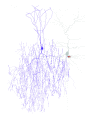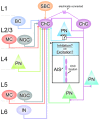Chandelier Cells in Functional and Dysfunctional Neural Circuits
- PMID: 27199673
- PMCID: PMC4854894
- DOI: 10.3389/fncir.2016.00033
Chandelier Cells in Functional and Dysfunctional Neural Circuits
Abstract
Chandelier cells (ChCs; also called axo-axonic cells) are a specialized GABAergic interneuron subtype that selectively innervates pyramidal neurons at the axon initial segment (AIS), the site of action potential generation. ChC connectivity allows for powerful yet precise modulation of large populations of pyramidal cells, suggesting ChCs have a critical role in brain functions. Dysfunctions in ChC connectivity are associated with brain disorders such as epilepsy and schizophrenia; however, whether this is causative, contributory or compensatory is not known. A likely stumbling block toward mechanistic discoveries and uncovering potential therapeutic targets is the apparent lack of rudimentary understanding of ChCs. For example, whether cortical ChCs are inhibitory or excitatory remains unresolved, and thus whether altered ChC activity results in altered inhibition or excitation is not clear. Recent studies have shed some light onto this excitation-inhibition controversy. In addition, new findings have identified preferential cell-type connectivities established by cortical ChCs, greatly expanding our understanding of the role of ChCs in the cortical microcircuit. Here we aim to bring more attention to ChC connectivity to better understand its role in neural circuits, address whether ChCs are inhibitory or excitatory in light of recent findings and discuss ChC dysfunctions in brain disorders.
Keywords: axo-axonic cells; chandelier cells; circuits; epilepsy; interneuron; schizophrenia.
Figures


Similar articles
-
Specific and comprehensive genetic targeting reveals brain-wide distribution and synaptic input patterns of GABAergic axo-axonic interneurons.Elife. 2024 Jul 16;13:RP93481. doi: 10.7554/eLife.93481. Elife. 2024. PMID: 39012795 Free PMC article.
-
Dense and overlapping innervation of pyramidal neurons by chandelier cells.J Neurosci. 2013 Jan 30;33(5):1907-14. doi: 10.1523/JNEUROSCI.4049-12.2013. J Neurosci. 2013. PMID: 23365230 Free PMC article.
-
Cortical control of chandelier cells in neural codes.Front Cell Neurosci. 2022 Oct 10;16:992409. doi: 10.3389/fncel.2022.992409. eCollection 2022. Front Cell Neurosci. 2022. PMID: 36299494 Free PMC article.
-
Activity-Dependent Plasticity of Axo-axonic Synapses at the Axon Initial Segment.Neuron. 2020 Apr 22;106(2):265-276.e6. doi: 10.1016/j.neuron.2020.01.037. Epub 2020 Feb 27. Neuron. 2020. PMID: 32109363 Free PMC article.
-
Lighting the chandelier: new vistas for axo-axonic cells.Trends Neurosci. 2005 Jun;28(6):310-6. doi: 10.1016/j.tins.2005.04.004. Trends Neurosci. 2005. PMID: 15927687 Review.
Cited by
-
Distinct patterns of GABAergic interneuron pathology in autism are associated with intellectual impairment and stereotypic behaviors.Autism. 2023 Aug;27(6):1730-1745. doi: 10.1177/13623613231154053. Epub 2023 Mar 19. Autism. 2023. PMID: 36935610 Free PMC article.
-
Inhibitory Synapse Formation at the Axon Initial Segment.Front Mol Neurosci. 2019 Nov 5;12:266. doi: 10.3389/fnmol.2019.00266. eCollection 2019. Front Mol Neurosci. 2019. PMID: 31749683 Free PMC article.
-
Identification of a Core Amino Acid Motif within the α Subunit of GABAARs that Promotes Inhibitory Synaptogenesis and Resilience to Seizures.Cell Rep. 2019 Jul 16;28(3):670-681.e8. doi: 10.1016/j.celrep.2019.06.014. Cell Rep. 2019. PMID: 31315046 Free PMC article.
-
Localized Myosin II Activity Regulates Assembly and Plasticity of the Axon Initial Segment.Neuron. 2018 Feb 7;97(3):555-570.e6. doi: 10.1016/j.neuron.2017.12.039. Epub 2018 Jan 25. Neuron. 2018. PMID: 29395909 Free PMC article.
-
Synaptic boutons are smaller in chandelier cell cartridges in autism.PLoS One. 2023 Apr 25;18(4):e0281477. doi: 10.1371/journal.pone.0281477. eCollection 2023. PLoS One. 2023. PMID: 37097993 Free PMC article.
References
-
- Baude A., Bleasdale C., Dalezios Y., Somogyi P., Klausberger T. (2007). Immunoreactivity for the GABAA receptor α1 subunit, somatostatin and connexin36 distinguishes axoaxonic, basket and bistratified interneurons of the rat hippocampus. Cereb. Cortex 17, 2094–2107. 10.1093/cercor/bhl117 - DOI - PubMed
Publication types
MeSH terms
Substances
Grants and funding
LinkOut - more resources
Full Text Sources
Other Literature Sources
Medical

